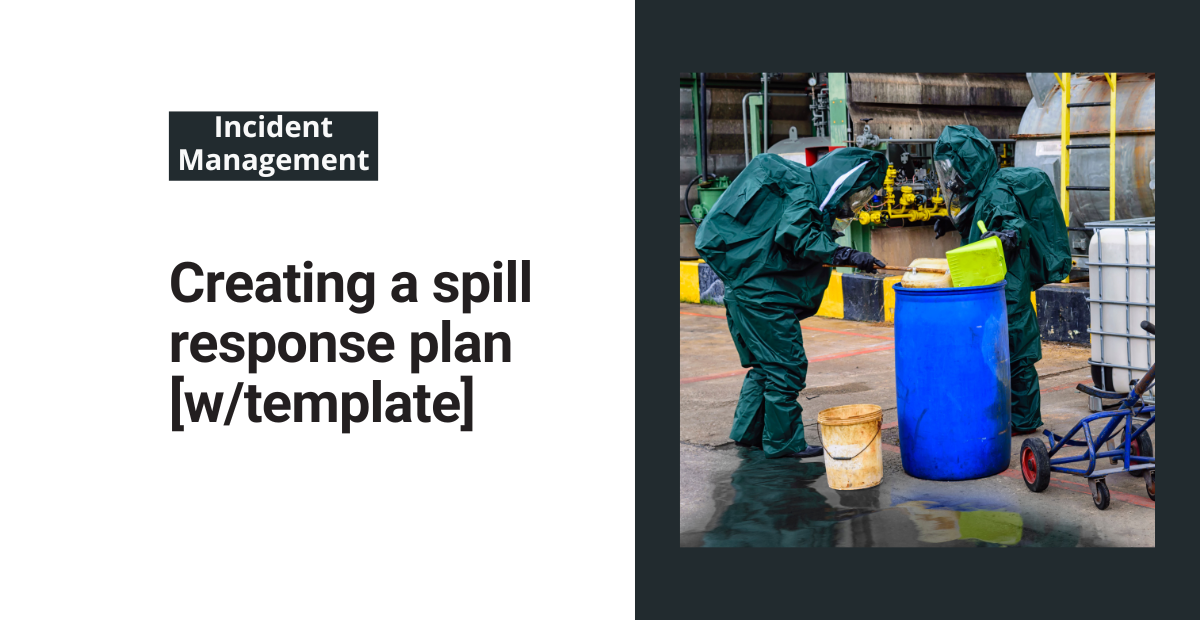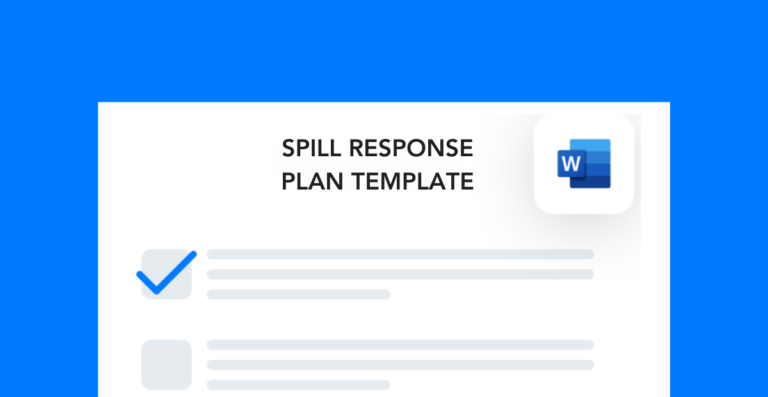A spill response plan is a blueprint for how a company will react if a chemical spill occurs. It is designed to prevent and mitigate chemical and oil spills, as well as to address emergencies that may arise from such accidents.
These plans typically contain information on the types of hazardous materials, storage locations, possible sources of leaks, and risk mitigation strategies. If your site is at risk of a spill event, you’ll need to develop a plan of your own.
Free template!
This spill response plan template provides an outline that you can fill in for a site-specific document.
Purpose of spill response plans
The primary objective of a spill response plan is to protect human health and the environment by minimizing the risk and negative impact of chemical spills. Preparing one will help you ensure that chemicals and oils are handled, stored, and transported in a manner that minimizes the risk of spills.
One of the key reasons to have response plans in place is that chemical spills can cause serious harm to human health, wildlife, and ecosystems. As a result, exposure to spilled chemicals may lead to acute or chronic health issues, including skin rashes, respiratory problems, burns, and chemical toxicity. Moreover, spills can contaminate the environment, creating ecological damage that may take years to reverse.
Another reason why plans are critical is that they help companies comply with regulatory requirements. Depending on the jurisdiction, companies may be legally required to maintain spill response plans. As a result, failure to comply can lead to fines or other legal consequences. Moreover, having a response plan in place helps companies meet regulatory requirements and contributes to overall public health and safety.
Contents of a spill response plan
Spill response plans provide guidance on a wide range of issues related to chemical and oil spills. Therefore, it’s important to include the following critical elements in every plan:
Prevention measures
First, outline procedures to prevent spills from occurring in the first place. This includes using spill prevention devices, spill kits, and physical barriers. Additionally, provide clear instructions on how to properly store and transport hazardous substances.
Notification procedures
Next, in the event of a spill, specify who to notify immediately. The notification process should include internal and external contacts such as emergency services, regulatory agencies, and cleanup contractors.
Spill response procedures
Similarly, like most EHS plans, spill response guidelines should outline the steps to take immediately after a spill occurs. This may involve:
- Evacuating affected area
- Containing the spill
- Shutting down equipment
- Notifying emergency services
Training and resources
In addition, the spill response plan should clearly list the roles and responsibilities of all staff involved in the response. This section must also outline the required training on spill response procedures, equipment use, and protective measures.
Other information to list includes:
- Appropriate cleanup PPE
- Cleanup materials
- Emergency response services
Check out our free oil spill response training course!
Documentation and reporting
The spill response plan should specify the process of documenting and reporting spills. Documentation guidelines should specify that the response record things like:
- Root cause
- Exact location
- Type and quantity of substances involved
- Corrective actions taken
The plan should also detail how to report spills to regulatory agencies and other relevant stakeholders.
Who enforces spill response plans?
Spill response plans are often subject to regulatory oversight, which means that various entities have a mandate to enforce compliance. These entities include:
Environmental Protection Agency (EPA): The EPA is charged with enforcing environmental regulations at the federal level. The agency has broad powers to investigate and enforce compliance with plans, including imposing penalties for non-compliance.
Occupational Safety and Health Administration (OSHA): OSHA enforces regulations that ensure a safe and healthy work environment. Specifically, the agency requires companies to establish procedures for handling hazardous materials and to train employees on safe handling practices.
In addition, state and local governments may have their own hazardous material regulations that companies must follow. These ordinances may require businesses to develop written plans and can impose fines for non-compliance.
Insurance companies: Insurance companies may require companies to have spill response plans in place before insuring them against environmental damages. Companies that fail to comply with these plans risk having their insurance policies canceled or premiums raised.
Spill response plans play a critical role in ensuring that hazardous chemicals and oils are handled safely while minimizing their impact on human health and the environment. Furthermore, these plans help prevent spills and enable companies to respond quickly and effectively. They provide clear guidelines for spill response procedures, notification, prevention measures, employee training, and proper documentation.




